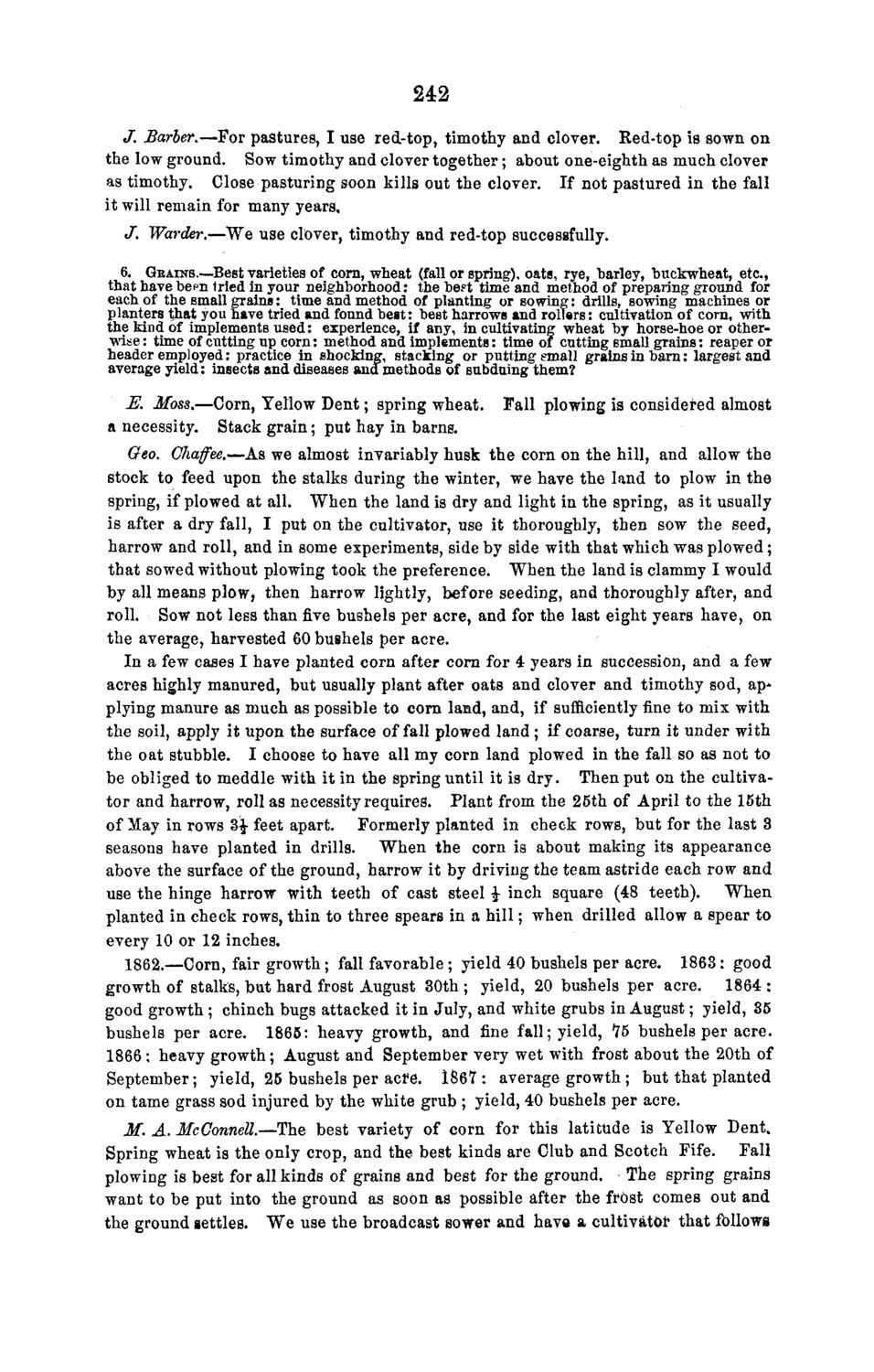| |
| |
Caption: Board of Trustees Minutes - 1868
This is a reduced-resolution page image for fast online browsing.

EXTRACTED TEXT FROM PAGE:
242 J. Barber.—For pastures, I use red-top, timothy and clover. Red-top is sown on the low ground. Sow timothy and clover together; about one-eighth as much clover as timothy. Close pasturing soon kills out the clover. If not pastured in the fall it will remain for many years, J. Warder.—We use clover, timothy and red-top successfully. 6. GEAINS.—Best varieties of corn, wheat (fall or spring), oats, rye, barley, buckwheat, etc., that have been tried in your neighborhood: the beet time and method of preparing ground for each of the small grains: time and method of planting or sowing: drills, sowing machines or planters that you have tried and found best: best harrows and rollers: cultivation of corn, with the kind of implements used: experience, if any, in cultivating wheat by horse-hoe or otherwise: time of cutting up corn: method and implements: time or cutting small grains: reaper or header employed: practice in shocking, stacking or putting gmall grains in barn: largest and average yield: insects and diseases and methods of subduing them? & Moss*—Corn, Yellow Dent; spring wheat. Fall plowing is considered almost a necessity. Stack grain; put hay in barns. Geo. Chaffee.—As we almost invariably husk the corn on the hill, and allow the stock to feed upon the stalks during the winter, we have the land to plow in the spring, if plowed at all. When the land is dry and light in the spring, as it usually is after a dry fall, I put on the cultivator, use it thoroughly, then sow the seed, harrow and roll, and in some experiments, side by side with that which was plowed; that sowed without plowing took the preference. When the land is clammy I would by all means plow, then harrow lightly, before seeding, and thoroughly after, and roll. Sow not less than five bushels per acre, and for the last eight years have, on the average, harvested 60 bushels per acre. In a few cases I have planted corn after corn for 4 years in succession, and a few acres highly manured, but usually plant after oats and clover and timothy sod, applying manure as much as possible to corn land, and, if sufficiently fine to mix with the soil, apply it upon the surface of fall plowed land; if coarse, turn it under with the oat stubble. I choose to have all my corn land plowed in the fall so as not to be obliged to meddle with it in the spring until it is dry. Then put on the cultivator and harrow, roll as necessity requires. Plant from the 25th of April to the 15th of May in rows i\ feet apart. Formerly planted in check rows, but for the last 3 seasons have planted in drills. When the corn is about making its appearance above the surface of the ground, harrow it by driving the team astride each row and use the hinge harrow with teeth of cast steel \ inch square (48 teeth). When planted in check rows, thin to three spears in a hill; when drilled allow a spear to every 10 or 12 inches. 1862.—Corn, fair growth; fall favorable ; yield 40 bushels per acre. 1863: good growth of stalks, but hard frost August 30th ; yield, 20 bushels per acre. 1864 : good growth ; chinch bugs attacked it in July, and white grubs in August; yield, 35 bushels per acre. 1865: heavy growth, and fine fall; yield, 75 bushels per acre. 1866: heavy growth; August and September very wet with frost about the 20th of September; yield, 25 bushels per acfe. 1&67 : average growth ; but that planted on tame grass sod injured by the white grub ; yield, 40 bushels per acre. M. A. McConnell.—The best variety of corn for this latitude is Yellow Bent. Spring wheat is the only crop, and the best kinds are Club and Scotch Fife. Fall plowing is best for all kinds of grains and best for the ground. Tne spring grains want to be put into the ground as soon as possible after the frost comes out and the ground settles. We use the broadcast sower and have a cultivator that follows
| |